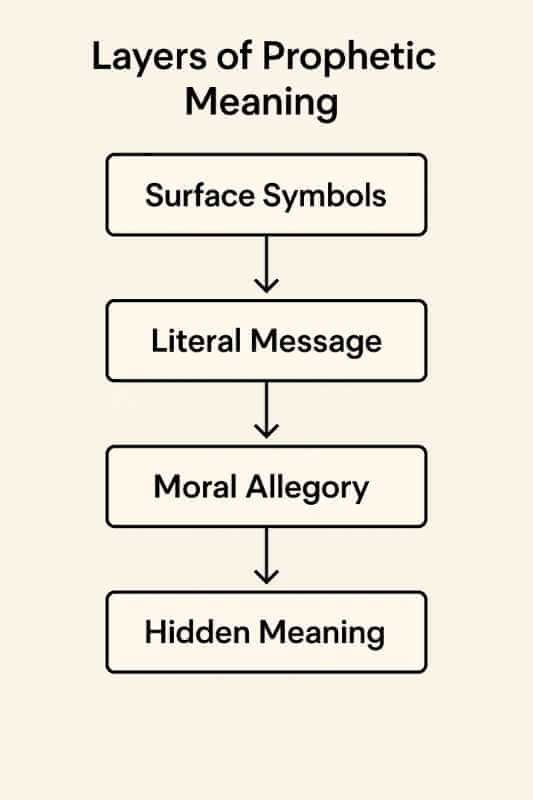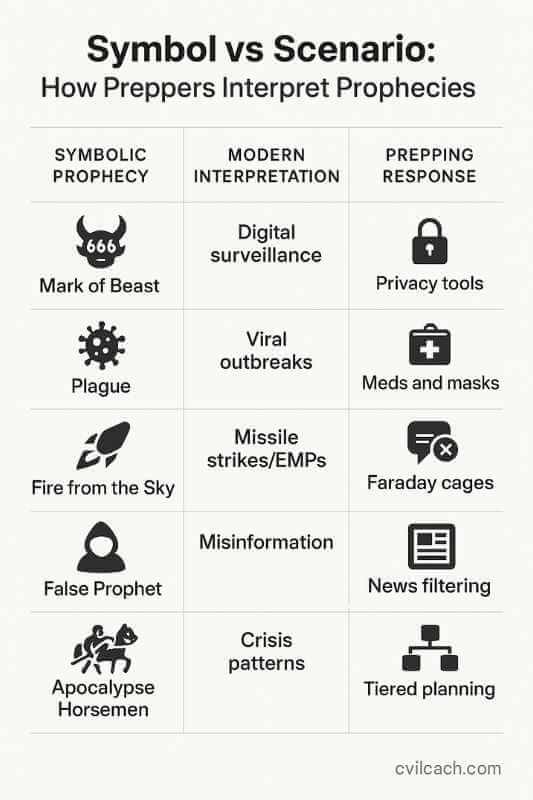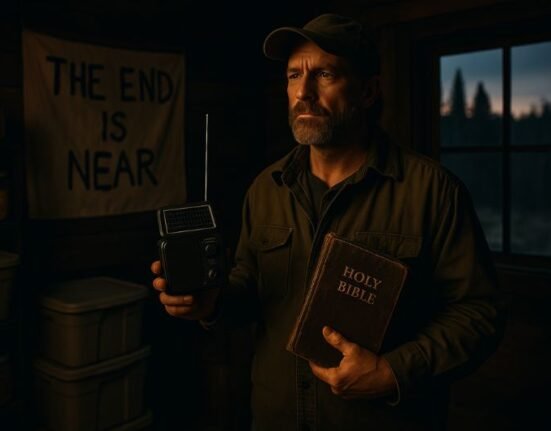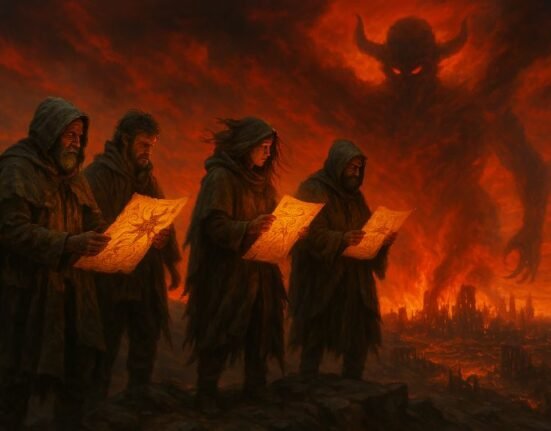For centuries, humanity has turned to end-time prophecies not just to predict the future, but to decode the present. From biblical visions to cryptic quatrains, these prophetic texts offer more than warnings—they offer frameworks for understanding fear, power, collapse, and survival.
In today’s world, where climate disaster, global pandemics, AI takeover, and nuclear threats feel more real than ever, these prophecies have resurfaced. But what do they actually mean? How do we decode ancient language in a world ruled by data and disinformation?
This article explores the hidden layers of meaning behind the world’s most influential apocalyptic visions—and what they reveal about our collective psyche, our cultural narratives, and our survival instincts.
The Layers of Prophetic Meaning: Literal, Symbolic, Strategic
When decoding end-time prophecies, it’s essential to understand that they function on multiple interpretive levels—often simultaneously. These aren’t just old predictions about fire and brimstone. They are layered texts that can be read as:
- Literal forecasts of future events
- Symbolic expressions of timeless fears and archetypes
- Strategic warnings meant to trigger behavioral or moral shifts
Literal: The Surface Level
Some followers—especially in fundamentalist religious communities—take prophecies at face value. For example, the Book of Revelation is read as a literal roadmap of future cataclysms, including the rise of the Antichrist, a global war, and divine judgment.
- Survivalist application: Literalists often build bunkers, stockpile rapture supplies, or align timelines with scripture.
- Risks: This reading can lead to paranoia, date-setting, and fatalism.
“They read the stars and scrolls as a schedule—not a story.” — Prepping Culture Analyst, 2022
Symbolic: The Archetypal Layer
Others—scholars, mystics, and psychologists—see end-time prophecies as symbolic narratives expressing deep archetypal truths. Carl Jung called them projections of the collective unconscious, filled with figures like The Beast, The False Prophet, or The Great Flood, all pointing toward cycles of death and rebirth.
- Survivalist insight: Symbolic interpretations allow us to draw lessons without fear: adaptation, moral clarity, and resilience.
- Examples: The “Mark of the Beast” as a metaphor for digital control, or the Four Horsemen as societal indicators (war, famine, plague, conquest).
Strategic: The Moral Catalyst
A third way to decode prophecy is strategically—as a warning designed to provoke reflection and action. In this reading, prophetic texts function like a siren: “Change course, or face consequences.”
- Application in prepper culture: This view leads to proactive readiness: off-grid migration, localism, ethical prepping.
- Historic echo: Medieval sermons used apocalypse visions to reform communities, just as today’s eco-preachers invoke climate collapse to change behavior.
Layers of Prophetic Meaning

| Interpretive Layer | Description | Modern Application |
|---|---|---|
| Literal | Taken word-for-word as a forecast | Bunker prepping, rapture kits |
| Symbolic | Seen as metaphorical/archetypal | Moral lessons, inner transformation |
| Strategic | Seen as behavioral triggers | Lifestyle changes, community resilience |
Ancient Prophecy vs. Modern Chaos: Why Interpretation Matters More Than Ever
In an era defined by information overload, fake news, and mass disorientation, the way we interpret end-time prophecies has become as important as the prophecies themselves. The world may not be ending—but it feels like it might be. And when the future looks uncertain, ancient warnings start to sound like headlines.
Old Visions, New Parallels
What makes these ancient texts so enduring is their strange relevance to our modern condition:
- Revelation’s beast echoes fears of mass surveillance and authoritarian AI
- Nostradamus’s quatrains are repurposed during each global crisis
- The Islamic Dajjal is reinterpreted as a metaphor for ideological warfare or media deception
- The Hopi purification cycle maps eerily onto ecological collapse
These parallels are not coincidences—they’re interpretive bridges. The prophecies didn’t change. We did.
“We no longer look to prophets for salvation—we look to them for pattern recognition.” — Cultural Anthropologist, H. Moraes
The Interpreter Effect
Who delivers the prophecy matters just as much as the message. In every age, interpreters—priests, imams, visionaries, influencers—shape the tone, urgency, and outcome of prophetic language.
- A doom preacher may use Revelation to instill panic
- A spiritual guide might see it as a message of renewal
- A prepper influencer can turn it into a checklist of supplies and signs
This “interpreter effect” amplifies confirmation bias. People look for signs that match what they already fear—or hope. That’s why decoding end-time prophecies today requires awareness of who’s doing the decoding.
Misinterpretation in the Digital Age
Modern media multiplies misinterpretations. TikTok “prophets,” YouTube doomsayers, and Twitter threads regularly:
- Mistranslate scripture or historical timelines
- Cherry-pick disasters to fit prophetic patterns
- Go viral, spreading fear without context
These distorted versions shape real behavior: market sell-offs, panic buying, urban flight, or worse—violent action. That’s why discernment is not optional anymore. In today’s chaos-driven society, prophecy isn’t just read—it’s weaponized.
“The problem isn’t prophecy. It’s viral misreading.” — Prepper Podcast: Signal & Sign
Survivalism and Meaning-Making
For the modern survivalist, decoding prophecy isn’t about mysticism—it’s about meaning-making. It provides:
- A framework for collapse
- A moral compass in lawless scenarios
- A way to prepare emotionally, not just logistically
In prepping culture, this can mean:
- Seeing the “Four Horsemen” as crisis indicators: war, famine, disease, inflation
- Understanding the “Great Tribulation” as the breakdown of global systems
- Reading prophecies as signals, not sentences
The best survivalists aren’t just tactical—they’re interpretive. They read the signs without getting lost in them.
From Prophecy to Action: How to Decode Without Falling Into Fear
Decoding end-time prophecies is not about retreating into paranoia or obsessing over every blood moon or global summit. It’s about learning to filter ancient wisdom through modern awareness—to prepare without panicking, to observe without becoming overwhelmed.
So how do you extract meaning without falling victim to fear?
Build an Interpretive Shield
Instead of treating prophecies as commands or exact blueprints, treat them as scenario tools. Here’s how:
- Cross-check sources: Don’t trust a single interpretation, especially if it goes viral without context.
- Anchor in historical knowledge: Understand the era in which the prophecy was written—who it warned, what it described, and why.
- Look for patterns, not predictions: Prophecies often reflect human cycles—hubris, decline, renewal—not exact dates.
“Interpretation is like a compass—it doesn’t tell you what will happen, but helps you navigate what might.” — Strategic Prepper, 2024
Translate Vision into Preparedness
The best decoding leads to action—not fear. Use these prophecies to map risk categories, not supernatural destiny:
| Prophetic Symbol | Modern Survival Mapping |
|---|---|
| Beast/Antichrist | AI control, authoritarian regimes |
| Great Flood | Sea level rise, infrastructure failure |
| Plagues | Pandemics, biowarfare scenarios |
| Fire Judgment | Urban warfare, civil unrest |
| Tribulation | Economic collapse, resource scarcity |
These associations help preppers plan rationally. If Revelation says “the stars will fall,” that’s not cause to panic—it may simply reinforce the need for off-grid resilience in the face of space weather or EMPs.
Symbol vs Scenario: How Preppers Interpret Prophecie

Conclusion: Discernment is the New Survival Skill
In an age of collapsing trust and rising chaos, the ability to decode end-time prophecies is less about religious belief—and more about strategic thinking.
These ancient visions endure not because they predict, but because they mirror. They reflect our deepest fears, our collective mistakes, and the cycles of civilization.
To survive the next crisis—be it spiritual, digital, ecological, or economic—we don’t just need supplies. We need interpretive clarity.
“Prophecies survive not because they were right, but because we still haven’t learned their lessons.” — Jungian survivalist M. Reyes
So read the signs. But read them wisely.
🧠 Frequently Asked Questions (FAQ)
Q: How can I tell if a prophecy is symbolic or literal?
A: This is one of the most crucial aspects of decoding end-time prophecies. The difference often lies in the language, imagery, and historical context used in the prophetic text.
Symbolic prophecies typically use dreamlike metaphors—dragons, seals, beasts with many heads, celestial signs—that evoke emotions or archetypes rather than specific future events. Examples include:
- The Book of Revelation, where “The Beast” and “The Scarlet Woman” are often interpreted as representations of political or moral corruption.
- Daniel’s visions, where hybrid animals and numbers symbolize kingdoms and time periods.
On the other hand, literal prophecies refer to real people, places, or measurable events—like the prediction of the destruction of the Second Temple in Jerusalem, which many historians agree aligns with historical outcomes.
➡️ Prepper tip: Unless you’re deeply familiar with the culture, language, and theology behind a text, assume symbolic interpretation first. It allows for flexibility in scenario planning and reduces the danger of rigid, fear-driven prepping.
Q: Can decoding prophecy help me become a better prepper?
A: Absolutely—if you approach it with clarity and skepticism. The real value in decoding end-time prophecies isn’t in knowing “what will happen”—but in expanding your risk imagination.
When read metaphorically, prophecies provide thematic guidance for identifying global threats:
- The “Plague” might inspire pandemic preparedness.
- The “Wormwood star” could suggest water contamination or a nuclear incident.
- The “Beast’s Mark” might be interpreted as digital control or biometric tracking.
➡️ Prophecies offer a narrative framework—a way to explore multiple threat vectors (supply chain collapse, grid failure, authoritarianism) through allegory.
Used this way, prophetic texts help preppers think beyond conventional scenarios, engage in tiered planning, and prepare not just physically, but psychologically.
Q: Are some modern events fulfilling old prophecies?
A: This is a common belief—and one that fuels many prepping communities. While no prophecy has been definitively “fulfilled” in a provable, literal sense, many current global events reflect themes described in ancient texts.
Here’s how prophecy overlaps with reality:
| Prophetic Symbol | Possible Modern Fulfillment |
|---|---|
| “Fire from the sky” | Ballistic missiles, meteor threats, space weaponry |
| “Pale Horse (Death)” | Global pandemics like COVID-19 |
| “Babylon the Great” | Symbolic of corrupt global empires or financial systems |
| “Sun darkened / Moon turned to blood” | Climate disruptions, eclipses, wildfires |
➡️ The key is this: correlation is not confirmation. Just because something looks similar doesn’t mean it is the prophecy being fulfilled.
In the practice of decoding end-time prophecies, the goal is to recognize patterns and respond intelligently—not to blindly follow anyone claiming divine timelines.
Q: Isn’t it dangerous to rely on prophecy at all?
A: Yes—and no.
Yes, if prophecy becomes your only lens, or if you abandon rational analysis in favor of fatalism or conspiracy thinking. This has led, historically, to mass hysteria, cult-like behavior, and even violence.
But no, if you approach prophecy as a mythical framework to organize your understanding of collapse. Prophetic language—like that in Revelation or Hopi teachings—doesn’t have to be true in the literal sense to be useful for insight, reflection, or preparation.
“Prophecy is not prediction. It’s pattern recognition through metaphor.” — Prepping Philosopher, 2024
➡️ Decoding end-time prophecies with discernment allows you to extract meaning without surrendering your reason. It’s about balance: seeing the symbols, learning the lessons, but staying grounded in facts and strategy.















